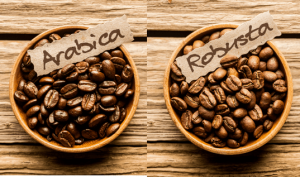The Differences Between Arabica and Robusta
Coffea arabica) and Robusta (Coffea canephora) are the two most common commercial coffees. When you’re shopping for coffee beans, these are the ones you’ll find. However, there are some significant differences between them that you, the home barista, should be aware of.
Taste
First and foremost, let’s start with the biggest distinguishing characteristic of Arabica and Robusta—taste. Arabica produces an aromatic coffee that comes from a high content of lipids and sugars, which help the coffee retain that desirable aroma. Arabica has 60% more lipids than Robusta and twice the sugar. It accounts for the majority of the world’s coffee production, and its singular flavor quality makes it the most prized among coffee connoisseurs. By contrast, Robusta is believed to be vastly inferior to Arabica. It has more caffeine than Arabica, which gives it a bitter taste often described as grain-like or rubbery, like burnt tires. It’s no surprise, then, that when it comes to taste, coffee experts say that Arabica is the winner, hands-down. Though, as we’ll see below, Robusta still has its place in the coffee universe.Caffeine Content
As stated above, Robusta has more caffeine than Arabica, which gives it a bitter flavor. On average, Robusta beans have 83% more caffeine than Arabica beans. But if you read a little further, there’s actually an advantage to Robusta’s higher caffeine content.Bean Shape and Tree Height
Arabica beans have an oval shape, while Robusta beans are rounder. Additionally, Arabica beans are larger and have an S-shaped crack on the flat side. The crack of a Robusta bean is more of a straight line. There is a significant difference in the height of the two plants as well. Arabica trees grow to a height of around 4.5 meters (14.8 feet), while the Robusta tree can reach up to 6 meters (20 feet).Growing Environments
Another major difference between Arabica and Robusta is where they are grown. Arabica grows best in subtropical environments with a temperature range between 59°F – 75°F. Additionally, it likes the shade and needs an elevation of around 1900 ft. or more above sea level. Countries that grow the most Arabica are in Africa and South America, with Brazil being the leading producer of Arabica. Meanwhile, Robusta thrives in hotter temperatures, lower elevations, and full sunlight. Robusta is grown in the Eastern Hemisphere, mainly in Asia and parts of Africa. Among countries where Robusta is grown, Vietnam produces the most.Resilience & Durability
Arabica is considered the best-tasting coffee by connoisseurs all across the board. However, there are a few catches. The growing conditions required for Arabica, as mentioned above, make it a very fussy, high-maintenance plant. It requires a specific environment with high elevations, warm temperatures, and rich soil. Additionally, it is vulnerable to insects and can easily be damaged by cold temperatures and improper handling. Basically, Arabica is a delicate plant that needs extra attention. By contrast, Robusta is a much tougher plant. Besides its ability to withstand harsher conditions than Robusta, there’s a considerable advantage to its extra caffeine content. The increased amount of caffeine in Robusta generates a greater level of chlorogenic acids. Also known as CGA, chlorogenic acids protect the coffee plants from harmful insects and other pests as well as diseases to which plants are vulnerable, including coffee rust and coffee berry disease. Since Robusta contains nearly twice as much CGA as Arabica, it’s a much more durable coffee plant.Price & Availability
While Arabica is considered the superior coffee, it’s more expensive than Robusta. Besides needing specific growing conditions and extra care, Arabica yields a lower harvest than Robusta. According to Statista.com, the average price per kilogram of Arabica in 2018 is US$3.28, compared to US$2.00 for Robusta. As a commodity good, the price of coffee is subject to change due to market fluctuation, weather conditions, and other factors, driving the cost either up or down. Another reason why Arabica is more expensive is the greater demand for it than for Robusta. Coffee brewers vastly prefer the smooth taste of Arabica to the harsh taste of Robusta, so of course, they want more Arabica. Since Robusta is cheaper, commercial coffee companies frequently use it as a filler in their products to cut costs. It’s also the main coffee bean used for instant coffee, which may be yet another reason for coffee experts to turn up their noses at Robusta.Arabica is Better than Robusta—Except When It’s Not
 It’s true that coffee experts prefer Arabica to Robusta. However, it’s worth mentioning that not all Arabica is of high quality. Likewise, there are excellent Robusta coffees.
And there are certain cases where Robusta serves a purpose. For instance, Robusta is highly desirable in Italian espressos. The reason for this is that Robusta produces a more excellent crema, the light-brown liquid that forms at the top of the espresso and gives it a fuller taste.
There may also come a time when coffee roasters and brewers will have to rely more on Robusta. Areas where Arabica is grown are coming increasingly under threat from changes in climate. These fluctuations include changes in temperature and rainfall, which can severely damage Arabica crops. This could potentially lead to an increase in demand for and production of Robusta.
Fortunately, some experts are already preparing for this scenario. In 2009, workshops were conducted to set standards for the quality of Robusta. These included discussions of cupping methods, roasting profiles, and grading. In addition, research is being conducted on growing conditions and improved cultivations methods to further raise the quality of Robusta coffee.
It’s true that coffee experts prefer Arabica to Robusta. However, it’s worth mentioning that not all Arabica is of high quality. Likewise, there are excellent Robusta coffees.
And there are certain cases where Robusta serves a purpose. For instance, Robusta is highly desirable in Italian espressos. The reason for this is that Robusta produces a more excellent crema, the light-brown liquid that forms at the top of the espresso and gives it a fuller taste.
There may also come a time when coffee roasters and brewers will have to rely more on Robusta. Areas where Arabica is grown are coming increasingly under threat from changes in climate. These fluctuations include changes in temperature and rainfall, which can severely damage Arabica crops. This could potentially lead to an increase in demand for and production of Robusta.
Fortunately, some experts are already preparing for this scenario. In 2009, workshops were conducted to set standards for the quality of Robusta. These included discussions of cupping methods, roasting profiles, and grading. In addition, research is being conducted on growing conditions and improved cultivations methods to further raise the quality of Robusta coffee.
Health Benefits of Arabica and Robusta
There has been plenty of research on the health benefits of coffee over the years. Arabica has several of these, but so does Robusta. Let’s take a look at each one. Arabica’s health benefits include:- Helping to prevent cancer
- Protecting the mouth, teeth, and gums (as long as you don’t put too much sugar in your coffee)
- Lowering your risk of Parkinson’s and Alzheimer’s diseases
- Regulating insulin levels in people with diabetes
- Maintaining healthy skin and nails
- Reducing stress, increasing energy and stamina, and just helping you feel good
- Promote weight loss
- Improve memory and concentration
- Boost cardiovascular health
- Relieve tension and fatigue headaches






